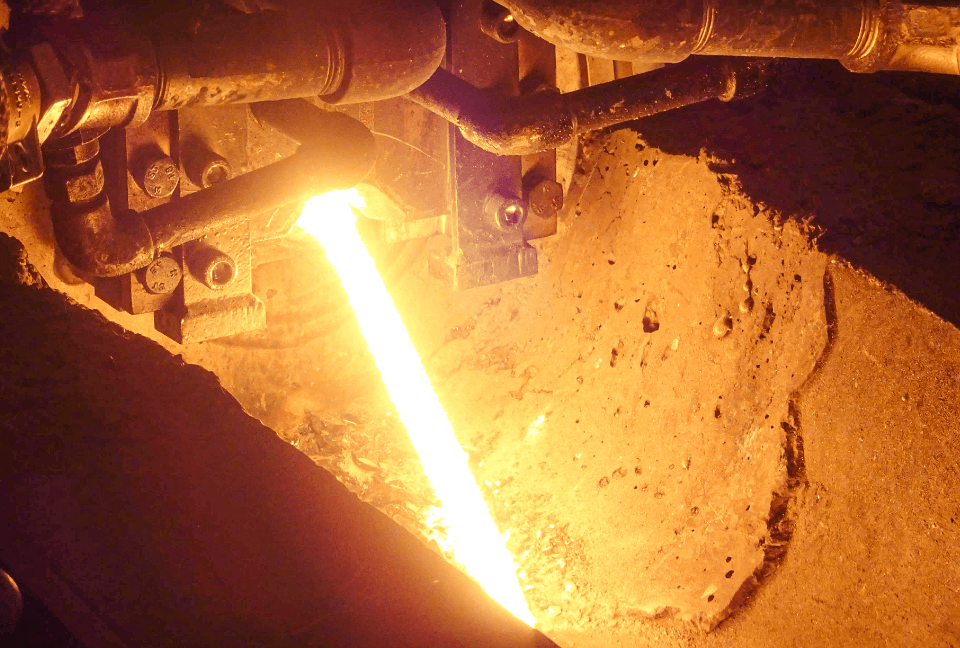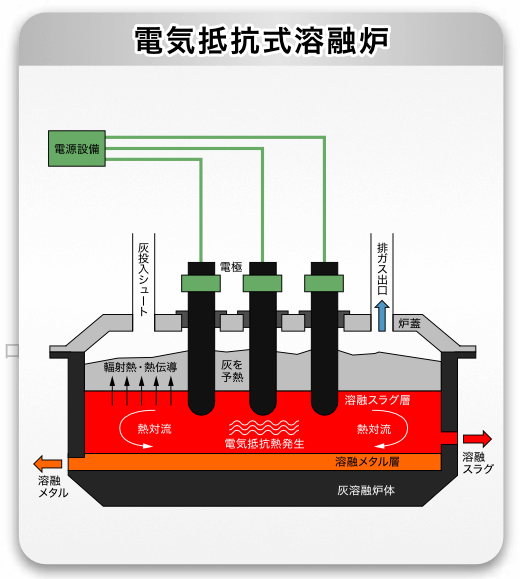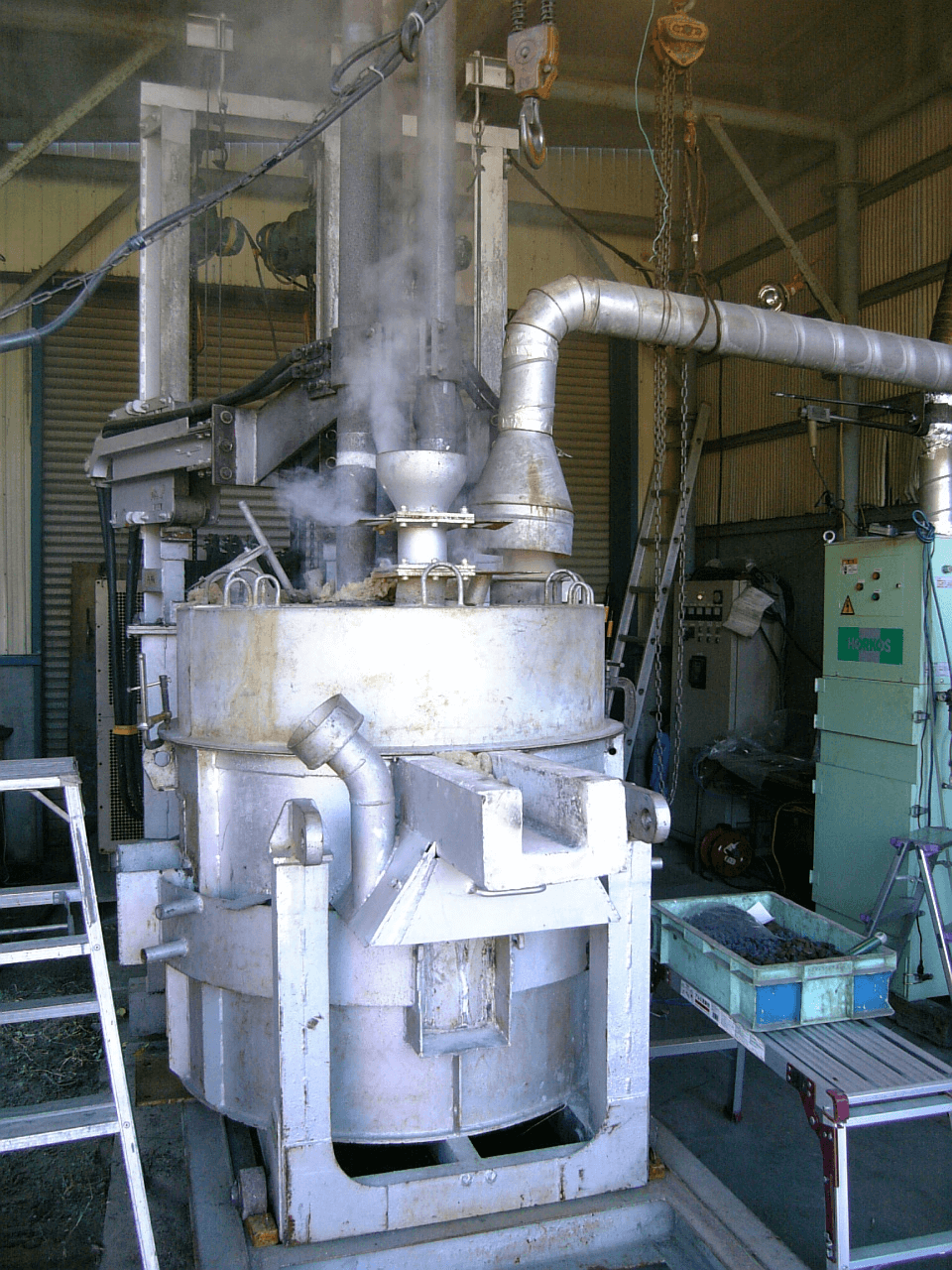Product Info
MELTING FURNACE
A melting furnace is a furnace that heats and melts an object to be heated by heat supplied from some high-temperature heating source. Tanabe offers electric resistance, plasma, and burner melting furnaces, depending on the heating source.

A melting furnace is a furnace that heats and melts an object to be heated by heat supplied from some high-temperature heating source. Tanabe offers electric resistance, plasma, and burner melting furnaces, depending on the heating source. Plasma and burner types have limited applications and processing volumes, but electrical resistance types have a track record of providing various applications and processing volumes. please inquire separately).
The features of the melting furnace differ depending on the heating source, but here we will explain the features of the electric resistance melting furnace.
Melting furnaces are classified into [Electric resistance type], [Plasma type], and [Burner type] depending on the heating source.

As electric resistance melting furnaces, Tanabe has been providing furnaces classified into submerged arc furnaces (SAF) and direct resistance furnaces for a variety of applications for many years. . It is called SAF because it operates with the electrodes submerged in the raw material or molten slag. In addition, since the raw material and molten slag inserted in the furnace are directly energized and heated by the Joule heat of the raw material and molten slag, the object to be heated becomes a heating source.
As a plasma type melting furnace, Tanabe offers a furnace classified as a DC arc plasma furnace for melting municipal waste incineration ash. A high-temperature plasma jet (20,000 to 30,000°C at the center) is emitted from a plasma torch inserted into the furnace to heat and melt the raw material. Since it is operated at a furnace pressure close to atmospheric pressure, it becomes a melting furnace that uses atmospheric pressure discharge plasma (thermal plasma) as a heating source among plasma (a state in which ions and electrons aggregate).
As a burner-type melting furnace, Tanabe offers a burner-type surface reflection melting furnace for use in melting municipal waste incineration ash. In this method, the raw material is heated and melted from the surface by the combustion heat of the burner and the radiant heat of the wall of the furnace body. By using a special burner whose flame spreads like a trumpet, and by arranging an appropriate number of burners according to the amount of processing, the surface melting efficiency of the raw material is enhanced.
The structure and mechanism of the melting furnace differ depending on the heating source, but here we will explain the structure and mechanism of the electric resistance melting furnace. After being transformed into high-current, low-voltage electricity in the furnace transformer, the electricity is supplied to the melting furnace through power supply equipment and electrode equipment. The electrode equipment has a function to raise and lower the electrode, and it is possible to control the power (current) applied to the melting furnace. Raw materials are charged into the furnace body lined with refractory material, and the raw materials are melted in the furnace body. In addition, the upper part of the furnace body is covered with a furnace cover lined with refractory materials. Various processes can be performed inside the melting furnace.
By melting raw materials containing oxides and reducing agents, and raising the temperature to a temperature higher than the reduction reaction temperature, it is possible to cause a reduction reaction (application examples: melting furnaces for manufacturing calcium carbide, melting furnaces for manufacturing ferroalloys, valuable metals melting furnace for reduction recycling).
It is possible to reduce the volume by melting the raw materials (Application example: Municipal waste incineration ash melting furnace).
Some of the heavy metals in the raw material are immobilized in the slag, making it possible to detoxify the slag by reducing the amount of toxic substances eluted from the slag to below the standard value (application example: melting furnace for melting municipal waste incineration ash).
It is possible to discharge raw materials in a molten state to subsequent equipment (example of application: melting furnaces in general, especially melting furnaces for rock wool production).
It is possible to melt the raw material, separate the slag and metal by specific gravity in the furnace, and discharge the slag and metal separately. furnace).
After processing, the metal and slag are discharged from the tapped holes drilled in the side wall of the furnace body by the tap opening/closing device, where they are cooled and solidified. Exhaust gas generated in the melting furnace is treated in exhaust gas treatment equipment, detoxified, and released into the atmosphere.
Calcium carbide (CaC2) is produced by heating a mixture of quicklime and coke to about 2000°C in a melting furnace, and is used for industrial production of acetylene, etc. It is also used as a deoxidizing and desulfurizing agent during steel smelting. View product details
Ferroalloy is a general term for various alloys of iron and elements that are desired to be deoxidized or added to special steel materials (including non-ferrous) in the steelmaking process. I'm here. There are two main types: closed type and semi-covered type.View product details
It is a valuable metal reduction recycling melting furnace that carbonizes the copper and precious metals contained in the incineration residue of waste substrates, and the metal oxides and neutralized sludge contained in the by-products of the stainless steel manufacturing process. Metal oxides are metallized by carbon reduction, and molten metal can be easily separated into metal and slag by specific gravity separation. View product details
This is a melting furnace for volume reduction and detoxification treatment of municipal waste incineration ash. We offer electric resistance type, plasma type and burner type melting furnaces depending on the heating source. The burner type is suitable for small and medium-sized incineration facilities that do not have waste power generation equipment. View product details
Furnaces for manufacturing heat insulating materials (rock wool) for various applications. There are two main types: the hot charging method, which uses molten blast furnace slag as the raw material, and the cold charging method, which uses rock as the raw material. For hot charging, a low energy consumption rate can be achieved. Using Tanabe's unique technology, the slag metering device can stably supply slag to the downstream cotton manufacturing line, achieving excellent product quality. View product details
Slag generated during copper smelting and refining contains a small amount of copper metal granules, which are sedimented to the bottom of the melting furnace by specific gravity separation and separated from the slag, thereby recovering copper metal. Since the slag is put into the melting furnace in the state of molten metal, the power supplied to the melting furnace is mainly consumed to keep the slag in the molten state.View product details
Tanabe can make engineering proposals not only for the main body of the melting furnace, but also for incidental equipment, and we will design the optimum according to the customer's request. In addition, we can also design and manufacture only incidental equipment, so if you have any incidental equipment you want, please contact us.
Equipment for supplying power to the electrodes of the melting furnace. We supply optimal equipment with reduced power loss based on our extensive experience and know-how. It is necessary to fully understand the production volume and the electrical properties (temperature and specific resistance) of the melt when designing power supply equipment and electrode equipment. Tanabe designs and provides optimal equipment based on data accumulated over many years of extensive experience. View product details
Equipment for raising and lowering the electrode of the melting furnace and controlling the electric power. It is necessary to fully understand the production volume and the electrical properties (temperature and specific resistance) of the melt when designing power supply equipment and electrode equipment. Tanabe designs and provides optimal equipment based on data accumulated over many years of extensive experience.View product details
A device that automatically replenishes artificial graphite electrodes (for 10 and 12 inches). By introducing an electrode replenishment device, it is possible to automate the work of manually replenishing electrodes.View product details
This is a device for tilting the body of the melting furnace and tapping the molten material inside the furnace. This is ancillary equipment used in cases where hot water from the tap opening is not suitable.View product details
It measures the weight of the melting furnace body and is used to control the amount of raw materials charged and the amount of slag and metal discharged. In principle, it cannot be installed at the same time as the furnace body tilting device.View product details
This is a device that controls the amount of slag hot water. It is installed in the melting furnace when you want to control the amount of molten metal received in the post-stage equipment for slag tapping.View product details
This is an automatic opening/closing device for the tap opening used when tapping metal and slag. A drilling machine is used to drill the tap opening on the side wall of the furnace body to release molten metal. When you want to stop hot water from coming out, use a mud gun to fill the tap opening on the side wall of the furnace with mud.View product details
This equipment cools and solidifies the metal and slag discharged from the melting furnace. We offer various methods such as linear endless type, trolley moving type, and circular type. The endless type separates and drops the cooling object by reversing the mold at the head. In the circular type, peeling is done via a mold reversing device.View product details
Equipment for casting slag discharged from the melting furnace.View product details
This is a device for removing flue gas dust adhering to the melting furnace flue (duct). The tip metal moves forward and backward while automatically rotating inside the duct, scraping off the dust that has adhered and accumulated.View product details
From large furnaces to small furnaces, we provide the optimum furnace cover for various melting furnace operations according to customer requests. The inner surface of the furnace lid is lined with refractory material, but it is also possible to provide only the furnace lid can body.View product details
In the verification test, it is possible to confirm whether or not the object to be melted can be melted, the melting state (melting point, fluidity, etc.), the reduction state if there is a reduction reaction, and the slag specific resistance value required for designing the actual melting furnace. Tanabe has a demonstration test machine for the introduction of an actual melting furnace, but it is currently being renewed.
Transformer capacity: 100kVA three-phase AC power supply
Furnace dimensions: φ660×H400mm
Electrode diameter: 4 inches (artificial graphite)
Melting temperature: 1200℃~1500℃

We will enhance the outer service after delivery of the melting furnace and contribute to the creation of the optimal operating environment for our customers.
regular maintenance
We propose the best maintenance according to the customer's shutdown period.
・Cleaning and replacing the seal part
・Replacement of spare parts and consumables
spare parts sales
We have various consumables and spare parts necessary for stable and continuous operation. We also offer equipment diagnosis during regular maintenance.
Support for remodeling work
We are carrying out remodeling work to realize further functions, such as remodeling the in-furnace mechanism to strengthen production capacity and change products.
The raw material heated by the heating source gradually rises in temperature, and when the temperature rises to the melting point of the raw material, it gradually melts from the surface of the raw material.
In the electric resistance melting furnace, the main heating medium is molten slag, so it cannot be melted unless there is a component that forms the basis of molten slag in the raw material components, or if molten slag is not always kept in the furnace. . Also, depending on the composition of the molten slag, it may not be suitable for the melting furnace, so please contact Tanabe with information on the raw material you want to melt and inquire. target).
We have a track record of melting furnaces (melting furnaces for manufacturing ferroalloys) with an inner diameter of 12.6m and a depth of 5.6m as the maximum size of the melting furnace. The maximum temperature of the melting furnace is about 2000℃ (melting furnace for manufacturing calcium carbide).
A refractory is installed inside the furnace body of the melting furnace, and this refractory is selected from materials that can withstand high temperatures, so it can be used as a melting furnace. In addition, the refractory can be used for as long as possible by cooling the furnace shell (called steel shell) with water.
It varies depending on the purpose and size of the melting furnace and the presence or absence of ancillary equipment, and raw material costs have continued to rise recently, so please inquire individually.
We have a track record of delivery in industries such as iron and steel (alloy ferrous), non-ferrous smelting, metal recycling, and waste disposal. Please contact us for the details of delivery record.
Reduction reaction treatment, volume reduction treatment, detoxification treatment, melting treatment, and gravity separation treatment are possible. For specific applications, Structure and Mechanism of the Melting Furnace AbovePlease refer to.
The material melted in the melting furnace is taken out by drilling the tap opening on the side wall of the furnace body with a drilling machine. By changing the height position of the tap mouth, it is possible to take out only the metal or only the slag.
If the raw material contains water, the evaporated water will accelerate the wear of the electrodes and refractories.
(Open) arc furnaces (Electrode Arc Furnace; EAF) are not handled by Tanabe.
Based on the technology and achievements we have cultivated over many years, we are able to build a highly reliable system and provide equipment that can efficiently supply electricity to the melting furnace.
melting furnace

Electric resistance melting furnace for small test

Furnace body weighing device

Furnace body tilting device

Furnace lid equipment

Melt cooling and solidification equipment

Copper wrought furnace

Electrode equipment

Electrode extension device

Electric resistance melting furnace (for valuable metal reduction recycling)

Electric resistance melting furnace (for ferroalloy manufacturing)

Electric resistance melting furnace (for melting ash)

Electric resistance melting furnace (for calcium carbide production)

Power supply equipment

Electric furnace for rock wool production

plasma melting furnace

Burner type melting furnace

Tap opening/closing device (drilling machine, mud gun)

Duct cleaning device

Slag metering device

slag conveyor
CONTACT
To Tanabe, world-recognized thermal technology
Please feel free to contact us.